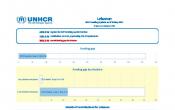Lebanon
Operation: Lebanon
Location
{"longitude":36,"latitude":34,"zoom_level":8}
Latest update of camps and office locations 21 Nov 2016. By clicking on the icons on the map, additional information is displayed.
Key Figures
| 2017 planning figures | |
| 170,000 | refugee households will receive winterization support, primarily through cash grants |
| 100,800 | emergency and life-saving hospital referrals for refugees |
| 50,000 | Syrian refugee children will be enrolled in primary education |
| 4,775 | resettlement registration forms (RRFs) will be submitted on behalf of refugees of all nationalities |
| 85% | of Syrian refugees will have access to legal assistance, including birth registration |
| 2015 end-year results | |
| 70% | of refugee households received cash and vouchers in the winter months |
| 60,000 | people were supported with life-saving hospitalizations, including for deliveries |
| 59,000 | children benefitted from co-financing of their school fees for the 2014-2015 school year |
| 19,300 | people were submitted for humanitarian admission and resettlement |
Latest Updates and Related Links
People of Concern
5%
Decrease in
2016
2016
| 2016 | 1,031,303 |
| 2015 | 1,088,231 |
| 2014 | 1,167,179 |

[["Refugees",1012969],["Asylum-seekers",13745],["Others of concern",4589]]
Loading ...
Lebanon
< Back
2016
{"categories":[2012,2013,2014,2015,2016,2017],"budget":[49.30505748,362.07406068,455.24766677,481.695910133,463.421994797,462.99368313],"expenditure":[45.04546824,246.02101412,304.00538602,318.76293313,350.84684491,null]}
{"categories":[2012,2013,2014,2015,2016,2017],"p1":[48.90104606,361.6342857,454.60838526,480.453635063,462.446930787,462.38738602],"p2":[0.40401142,0.43977498,0.63928151,1.24227507,0.97506401,0.60629711],"p3":[null,null,null,null,null,null],"p4":[null,null,null,null,null,null]}
{"categories":[2012,2013,2014,2015,2016,2017],"p1":[44.64466381,245.77783559,303.69096792,318.55729708,350.04193388,null],"p2":[0.40080443,0.24317853,0.3144181,0.20563605,0.80491103,null],"p3":[null,null,null,null,null,null],"p4":[null,null,null,null,null,null]}
Loading ...
CHOOSE A YEAR
- 2014
- 2015
- 2016
- 2017
Working environment
The socio-economic situation of Syrian refugees in Lebanon remained precarious despite humanitarian interventions.Policy restrictions on residency renewal affected the enjoyment of basic rights and freedom for refugees of all nationalities in Lebanon. Access to territory, UNHCR registration, and livelihoods remained the main challenges faced by Syrian refugees.
Conditions for voluntary repatriation in safety and dignity were unmet. Opportunities for resettlement were also limited, in particular for refugees coming from countries other than Syria. Gaps in the nationality law and a complex civil registration system continued to hamper birth registration and increased risks of statelessness.
Population trends
- Per capita, Lebanon hosts the highest number of Syrian refugees in the world.
- The total registered Syrian population decreased by almost 58,000 due to departures for resettlement and other pathways, spontaneous returns, and natural deaths, coupled with the suspension on new registrations since 2015.
- Lebanon also hosts nearly 22,000 people of concern from countries other than Syria, with Iraqis constituting the majority.
Achievements and impact
- UNHCR advocacy successfully contributed to removing two of the barriers to residency renewal, facilitating residency renewal for refugees who could meet the other conditions, including fees.
- Nearly 49,000 families received regular monthly multi-purpose cash assistance from UNHCR and other partners to assist them in meeting their needs in a dignified manner.
- 90 per cent of targeted households received seasonal cash assistance to purchase winter items.
- Intensive outreach contributed to the enrolment of 194,750 non-Lebanese children in primary and secondary school.
- UNHCR continues to play a strategic leadership role in coordinating and mobilizing partners for the refugee response while engaging closely with United Nations partners, to ensure sustainability of the response by supporting public institutions. The Lebanon chapter of the Regional Refugee and Resilience Plan (3RP), the Lebanon Crisis Response Plan (LCRP), now has 95 appealing organizations and institutions, including the Government.
Unmet needs
- UNHCR could only cover the monthly multi-purpose cash needs of 24 per cent of the total severely vulnerable refugee population.
- 120,000 refugees could not have their UNHCR refugee registration certificates renewed, due to resource constraints.
UNHCR’s overarching strategy in Lebanon will continue to focus on strengthening institutional support for protection and community-based protection activities. Ensuring the inclusion of refugees in Government policies and development plans, particularly by building understanding of the specific needs of refugees and enhancing the capacity of service providers, will be a priority objective for the Office.
UNHCR will continue to coordinate the overall refugee response in Lebanon, working closely with Government, UN and non-governmental partners. The Office will maintain its inter-agency commitment to address the most basic needs of refugees, and invest in host community support projects, public services and institutions. Advocating for access to those in need of immediate international protection will remain an area of focus.
A legal aid programme will be introduced to provide refugees, asylum-seekers and stateless people with better access to legal documentation and assistance in case of arbitrary detention and unlawful evictions. UNHCR will also seek to strengthen community-based protection by capitalizing on refugee and host community competencies and skills. Particular attention will be given to supporting the most vulnerable (including people with disabilities, the elderly, minority groups, and the socially marginalized) and to ensuring social cohesion within their communities.
Non-Syrian refugees represent less than 1 per cent of the total population of concern to UNHCR in Lebanon, with a total of 16,000 non-Syrian refugees and asylum-seekers from various countries including Ethiopia, Iraq, and Sudan. The priority will be to harmonize the response for non-Syrian refugees with that of the Syrian programme, to ensure that assistance reaches the most vulnerable.




